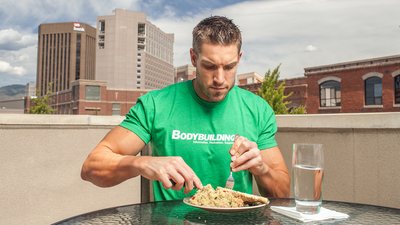You clicked on this article because you're hungry. All. The. Time. No sooner do you finish a meal than your stomach starts gurgling and growling, letting you know in no uncertain terms that you need pound back more food. It may make you wonder whether you have some sort of superhero metabolism, or if you're just not eating enough of the right foods at mealtime.
When was the last time you ate? If it was three or more hours ago, you're probably just due for your next meal. But if you ate an hour ago and your stomach is already starting to complain, it's probably time to look at what you're eating. Try these three tips to keep your belly feeling full and happy!
1. You Don't Drink Enough Fluids
Our bodies need a lot of fluids every day to optimize cognitive and physical performance. The average woman should drink a minimum of 96 ounces of fluid a day (about 12 cups), while the average man needs at least 125 ounces (about 16 cups or 1 gallon).[1,2] That's a lot of liquid for your average busy person to consume every day. And if you're training, you need to drink even more.
For every 15 minutes you work out, you should drink another 5-8 ounces of fluid. That means if your workout lasts 60 minutes, you need to get another 20-32 ounces. One of the easiest ways to drink enough water is to carry around a water bottle. Not one of those tiny 8-ouncers, either; invest in a container that will hold one-fourth to one-half of your daily goal.

The mother of all fluids, water, can do a lot to help you deal with hunger pangs. First of all, it helps create a feeling of fullness. When you consume water (or any fluid), your stomach expands, which sends a signal to your brain that you are full.
Then there are those times when our bodies get confused. For example, we don't usually feel thirst until we're already slightly dehydrated. And our brains can confuse thirst with being hungry. Our brains tell us we need to eat, when all we really need to do is drink!
Keep filling up on fluids—preferably calorie-free fluids—and you can keep that relentless appetite of yours in line.
How to get more liquids: Keep a water bottle attached to your hip. Bring it with you in the car and into meetings. Put one at your desk during the day and on your nightstand overnight. Take a gulp every time you look at it, and keep replenishing it with a variety of fluids. Fill it with sports drinks when you're working out and with low-calorie juices and water when you're not.
If your hunger really gets out of hand, try drinking 12-16 ounces of water immediately before and after each meal to make sure your brain gets the signal that you are full! Then, just keep taking in those fluids until your next meal.
2. You Don't Eat Enough Fiber
Fiber is often one of the most overlooked parts of our diets. We think a lot about getting our macros—our carbs, fats, and protein. But our bodies need fiber too. In fact, the recommended daily intake for fiber is 38 grams for men and 25 grams for women.[3]

But how much fiber people actually consume tends to be a lot less than that: 18 grams for men and 15 grams for women![4] Considering the powerful appetite-suppressing punch fiber packs, you might want to make sure you're getting at least the daily recommended amount—and it's not that hard to do.
How to get more fiber: Just by swapping white carbs (white bread and pasta, white rice, and white potatoes) for brown carbs (whole-grain breads and pastas, brown rice, and oats) you can increase your fiber by 4-5 grams per meal. Another great source of fiber is flaxseed. At 3 grams per tablespoon, flaxseed can give a big fiber boost to your morning oats, post-workout smoothie, or nightly Greek yogurt!
3. You Don't Eat Enough Vegetables
I'm talking about a minimum of three servings (one handful is a serving) of leafy greens and bright orange, red, or yellow veggies such as carrots, beets, and peppers each day.

Vegetables suppress those feeling of hunger, because they're about 90 percent water—and loaded with fiber. Daily-double special! Veggies also contain very few calories per bite, so you can eat just about all of them you want without breaking the calorie bank.
How to get more vegetables: Consider sneaking in vegetables throughout your day by hiding them in smoothies, omelets and scrambles, and sandwiches. Or just have them straight up; they're pretty tasty fresh or slightly undercooked.
References
- Sawka, M.N., Burke, L.M., Eichner, E.R., Maughan, R.J., Montain, S.J. & Stachenfeld, N.S. (2007). ACSM Position Stand: Exercise and Fluid Replacement. Medicine and Science in Sports and Exercise, 39(2), 377-390.
- Casa, D.J. & Clarkson, P.M. (2005). American College of Sports Medicine Roundtable on Hydration and Physical Activity: Consensus Statements. Current Sports Medicine Reports, 4, 115-127.
- Dietary Guidelines for Americans, 2010. (2010). Accessed June 30, 2016. Retrieved from: http://health.gov/dietaryguidelines/dga2010/dietaryguidelines2010.pdf.
- Reicks, M., Jonnalagadda, S., Albertson, A. M., & Joshi, N. (2014). Total dietary fiber intakes in the US population are related to whole grain consumption: results from the National Health and Nutrition Examination Survey 2009 to 2010. Nutrition Research, 34(3), 226-234.



